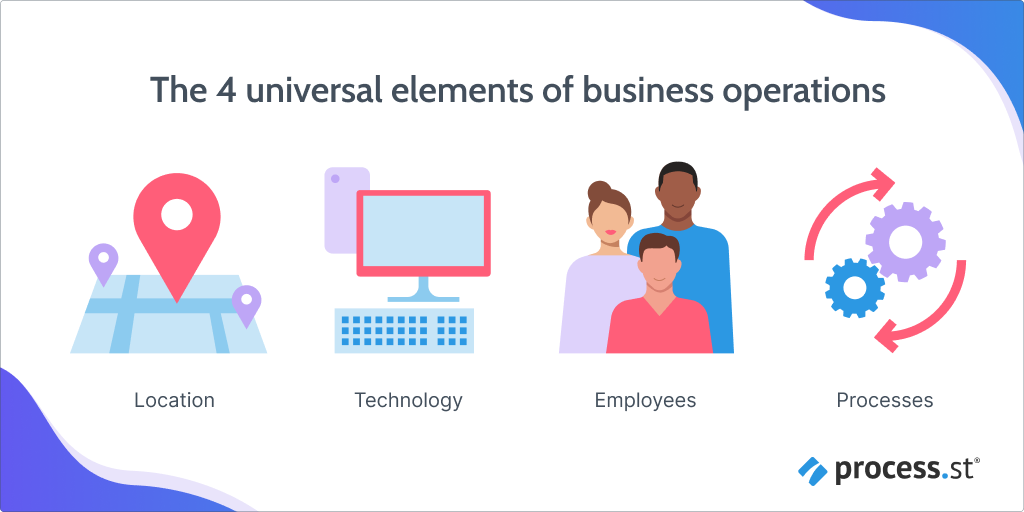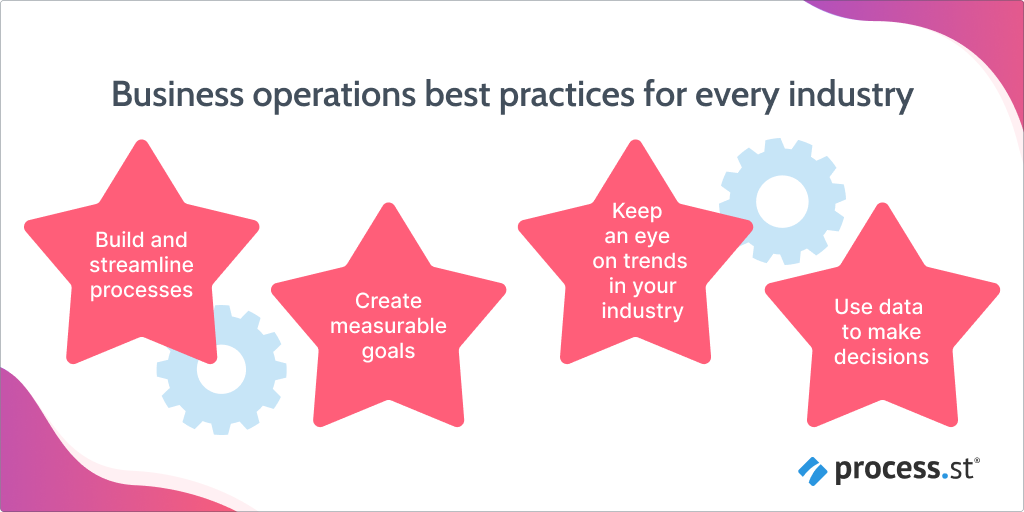Get started quickly, see results immediately, no code needed.
What are Business Operations? Definition, Examples, and Best Practices
When I first started working in the corporate world, there was a term that I noticed was thrown around a lot: BizOps.
What the heck is BizOps?? And why is there a whole department for it? What do they do??
It was a mystery that I eventually had to look up so as not to appear as ignorant as I was to my colleagues.
For those of you out there going through the same struggle, BizOps is short for business operations, and they are incredibly important to a business.
Let me walk you through it.
What are business operations?
Business operations have a pretty broad scope. Basically, it involves every part of a business that keeps it running and making a profit.
It’s those day-to-day tasks that keep everything operating smoothly. There’s no one-size-fits-all approach to business operations because every company is different.
It’s going to look totally different between a financial company and a manufacturing company, for example. It’s even going to look different between retailers if they are brick-and-mortar or online.
But don’t worry. The basics of business operations are universal, so let’s talk about them.
Elements of business operations
There are four elements that make up business operations that don’t change from industry to industry. They are simply adapted in their own unique ways.

Location
All new companies must choose a location where they will operate. Whether it be remote, a downtown high-rise, or a rural manufacturing plant, the importance of the decision remains the same.
And that decision, believe it or not, is part of business operations. It affects everything from:
- The pool of available customers
- Physical storage
- Company layout
- Employee parking
It’s essentially the most basic building block of your business operations.
How do you expect operations to run smoothly if you have hundreds of employees searching for parking every day? Or not enough space to store documents and products?
They simply won’t.
Technology
Technology is a massive part of business operations. And it includes everything from factory equipment to inventory tracking software. Literally any technology you use to run your company is part of business operations.
It’s important to understand what technology is important in order to streamline operations and stay up to date on all technological advancements. That way, you can always stay competitive.
Employees
You are nothing without your employees. The cornerstone of any business is figuring out what employees you need, how many, and if they should be full-time, part-time, or contracted.
The key to good business operations is building a well-balanced pool of talent. You have to find the sweet spot of having enough employees to keep operations running smoothly without over-hiring or overworking them.
It’s not easy, but it can really change the game for businesses.
Processes
Last but not least, processes. Considering the company I work for is called Process Street, it’s safe to say that this one is a favorite.
Your processes are the recurring tasks that keep businesses afloat. These are things like:
- Employee onboarding
- Invoicing
- Market research
- Recruitment
- Filing customer complaints
- Manufacturing a product
You get the picture. These smaller, everyday processes are essential for running a successful business, but only if they are done well.
One could argue that this is the most important aspect of business operations because it’s what keeps things moving. If you have struggled to improve your business operations, it’s wise to start by examining your processes to find inefficiencies.
Business operations examples
The elements of business operations are good and all, but what does it actually look like in practice? Here are some examples:
Human resources
HR is in charge of all operations relating to the employee lifecycle, including:
- Recruitment
- Onboarding
- Performance management
- Offboarding
And everything in between.
If the HR team can’t optimize these operations, it can have major consequences for a company’s talent pool. Good onboarding has the potential to increase employee retention by as much as 82%. That’s major!
In order to optimize HR operations, daily tasks might include things like looking for ways to improve employee satisfaction and creating new onboarding processes. Though different, they are both important for business operations.
Marketing
You can’t sell something without marketing, right? All the recurring processes your marketing team has to get the word out there about your product or service fall under the umbrella of business operations.
But I’m not just talking about the flashy campaigns they make or SEO-friendly posts they write. I’m also talking about the backend parts of marketing. Because a well-established process for approving marketing materials is just as important as the materials themselves. Operations run more smoothly when there are approvals and, thus, accountability.
Marketers are also responsible for gathering well-researched market information, a daily task that can make a massive difference to a company’s profits. So if it’s not done well, it can cost more than it’s worth.
Sales
Business operations in sales is all about making sure the sales team has the maximum amount of time in the day to try and make a sale.
If sales reps have to spend too much time logging information or coming up with sales strategies, then it’s an example of poor business operations.
But making sure all the processes that go on behind the scenes of sales meetings and cold calls run smoothly means your reps can spend as much time as possible with a customer to build relationships and lock in a sale. That, in turn, increases profits and is an example of good business operations.
To achieve that, you may want to consider things like automated workflows to save your sales team time. That ties in with using technology to enhance your business operations.
Finance

This covers everything to do with a company’s finances, along with financial decision-making.
This is probably the most sensitive one of them all because one blunder could ruin a business forever. For these business operations, it’s not about operating efficiently, it’s about operating correctly.
As such, their daily tasks include things like:
- Creating investment strategies
- Managing transactions
- Doing payroll
- Making financial reports
- Auditing
Like marketing, all of the processes listed above should come with a sub-process that approves each of them to avoid errors. Without it, it’s only a matter of time before someone makes a mistake that costs a company a lot of time and money.
Product
Of our five examples, this one is the broadest because it covers everything from the making of an actual product to the product team.
The goal of operations as it relates to product is to make sure the product team has all the information they need (budget, reporting, etc.) to come up with improvements to the product based on customer feedback. In turn, the product team lays out these changes to the team in charge of making the product.
To achieve this, recurring processes should be established to ensure the product team is always given new information from other teams when it arises. Without that in place, the product team can’t do their jobs properly. And if that’s the case, the product can’t improve, which can hurt sales.
Business operations best practices
If it isn’t clear by now, business operations are all interconnected. If one department is failing in its operations, it can have a domino effect on other departments. That’s why you need to adopt the best practices for business operations across the board so your organization can function like a well-oiled machine.

Streamline processes
Operations are nothing without processes. Processes are the building blocks that make up good operations. If you streamline your processes, you automatically streamline your operations.
There are several things you can do to make this happen.
- Look for inefficiencies in current processes
- Analyze outcomes
- Automate recurring tasks
- Get employee feedback
- Make adjustments
Automating recurring tasks is a big one because it saves your team from doing menial work that takes a lot of time. Time they could be spending on more high-value tasks.
Using business process software is a great way to automate those tasks and decrease overall inefficiencies in processes. While most do cost money, it’s a worthy investment because it ultimately saves you more money than you spend by improving your overall operations.
Measure performance
Come up with realistic and measurable goals for your business. By doing this, you can more easily analyze performance. It’ll also allow you to pinpoint the specific areas that need improvement. Which departments are slowing operations and why?
These goals should be specific. If your goal is to turn more profit in the next quarter, you won’t be able to measure much from that. But if your goal is to increase profits by 10%, then you can share that number with your employees and they know what to work towards.
If you don’t meet that goal, you can go to each department and talk to them about their operations to figure out the problem.
Watch trends
One of the worst things you can do is become stagnant in your operations. The whole if-it-ain’t-broke-don’t-fix-it attitude. Maybe it applies to certain situations, but not to business operations.
Trends can include changes in the market and industry, new technology, new laws, and changes in the economy. In order to remain competitive, you must stay on top of them and be open to making changes.
We call it the policy of continuous improvement. Never settle and think that what you’re doing is good enough. There are always improvements that could be made. Watch new trends and listen to feedback from your customers and employees to make sure you don’t become the next K-Mart.
Use data to make decisions
Lastly, you need to trust data and use it to make decisions. As much as we want to make decisions based on our feelings or past results, they aren’t always the best indicators of where we should go.
Most business process management software comes with an analytics and reporting feature that allows you to look at the metrics of all the processes used. That’s a great place to start when looking for data.
This is also where trends come back into play. Looking at things like inflation, new local policies, and industry polls can tell you what adjustments you need to make in order to improve operations.
Combine the two sets of data, and you’ll be unstoppable!
One last thing
Because business operations is such a broad term, it can be difficult to know where to start if you are interested in improving it.
Don’t worry, just take everything one step at a time. You can simply start by writing down all the different processes used in each department. From there, you go to the department heads and get information on how the processes currently run.
After that, it should start to become clear which areas you need to improve to have the most optimized business operations. Don’t be intimidated. You can do it!







 Workflows
Workflows Projects
Projects Data Sets
Data Sets Forms
Forms Pages
Pages Automations
Automations Analytics
Analytics Apps
Apps Integrations
Integrations
 Property management
Property management
 Human resources
Human resources
 Customer management
Customer management
 Information technology
Information technology


